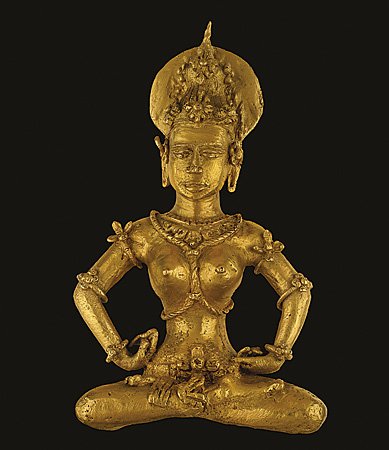Cultural Center of the Philippines
ENCYCLOPEDIA OF
PHILIPPINE ART
[Golden Tara of Agusan]
13th-14th century / Solid-cast gold / Height 12 cm, weight 1.8 kg / Artist: Anonymous / Grainger Hall of Gems, Field Museum of Natural History, Chicago
What is known as the Golden Tara of Agusan is currently housed at the Grainger Hall of Gems at the Field Museum of Natural History in Chicago. It is 12 cm tall, of at least 18-karat gold, solid-cast, and weighs 1.8 kg. The period between the late 13th to the early 14th century has been proposed as a date for this image. There is some lore surrounding its origin and provenance, but the story of its discovery in 1917 is borne out by the only known primary documentation from this period, written by the American anthropologist Henry Otley Beyer.
Beyer’s account states that the image was accidentally found in Esperanza, Agusan, by an unidentified woman. Some have suggested that she was a Manobo, after Beyer cited a statement by the ethnologist John M. Garvan who mentioned that Manobo leaders claimed the image had been secretly kept by some members for many generations, until it was lost in a flood in the late 19th century (Kelly 2011, 262). The image was found protruding out of the mud on the left bank of the Wawa River, a tributary of the Agusan River, after a storm and flood. A local government official named Blas Baklagon acquired the image from the woman, and brought it to the attention of Beyer in 1918. Beyer, who was then chair of the Department of Anthropology at the University of the Philippines and concurrent honorary curator at the National Museum, made representation to the American colonial government for the purchase of the image for the Museum. Unfortunately, this proved unsuccessful as the government claimed it had no available funds for this purpose. The Agusan Coconut Company eventually took ownership of the image from Baklagon, who owed the company an extensive debt.
In 1920, Dutch art historian F. D. K. Bosch, a colleague of Beyer, examined photographs of the image and briefly commented on them in a letter to Fay-Cooper Cole, then Southeast Asian curator at the Field Museum in Chicago (Cole incidentally had also conducted extensive ethnographic fieldwork in the Philippines). As word of the image spread, it sparked the interest of Mrs Louise Adriana Wood, wife of Leonard Wood, then United States governor-general in the Philippines. Fearing that the image might be melted down for its value in gold, Mrs Wood enlisted the help of Cole and Shaler Matthews, a professor in the Divinity School at the University of Chicago, to raise funds for its purchase. In 1922, the image was successfully acquired for the museum.
The Agusan image depicts a seated female figure in the padmasana or full lotus position, with the legs folded and crossed, and each foot resting on the opposite thigh. She is oriented frontally, and wears considerable ornamentation consisting of a floriated mountain-shaped crown and a halo, neck adornments, a long chain crossing her breasts and back, a low waistband with a quatrefoil near the navel, and floriated rings on the upper arms, elbows, and wrists. She has a rather longish face, with a wide forehead, slightly downcast eyes, a wide nose, full lips, and a short chin resting on a strong neck. Her torso, lean but with pronounced breasts, is carried regally, while her arms are akimbo with fingers curled inward, the backs of her hands resting on her hips. Two loops at the bottom of the image might have secured it to a base previously, but are now missing.
While these features are clearly apparent, the identity of the Agusan figure continues to be a matter of contention. Beyer suggested that she was a Saivite goddess, while his art-historian colleague Bosch posited that she might have represented a Mahayana Buddhist tara. Later, Juan Francisco argued that closer links to Buddhist, rather than Hindu, images in Southeast Asia made her more likely an Indo-Javanese queen, a goddess of Mahayana Buddhism or a tara associated with Tantric Buddhism. Tibetan scholar Rob Linrothe, on the other hand, identifies the Agusan image as one of the four “inner” offering goddesses in a three-dimensional Vajradhatu, or Diamond World, mandala (a cosmic diagram). This offering goddess is identified as Vajralasya, who is always shown with her hands on her hips.
Stylistically, the Agusan image has been linked to East Javanese (Nganjuk) images, although scholars do not discount production of the image in the Philippines, either by local artists or by foreign artist residents in the area. The presence of the image in the Philippines allows for conjectures on a possible Hindu-Buddhist period in the country (most likely related to the Sri Vijaya and Majapahit cultures of Indonesia) prior to the introduction of Islam and Christianity.
Written by Marilyn R. Canta
Sources
Bronson, Bennet. 1975. “Field Museum’s Agusan Gold Image: ‘The Most Spectacular Find Made Yet in Philippine Archaeology.’” Field
Museum of Natural History Bulletin, Jan, p. 5.
Calo, Macky. 2011. “Desperately Seeking Tara: An Attempt to Find the Golden Tara of Agusan.” Travel Book, 25 Jul.
Capistrano-Baker, Florina H. 2011. “Butuan in Early Southeast Asia.” In Philippine Ancestral Gold, edited by Florina H. Capistrano-
Baker, 193-261. Makati City: Ayala Foundation; Singapore: NUS Press.
de Jesus, Vicente C. 2005. “Agusan Gold Image: Sui Generis.” Amangpulo (Yahoo! Groups), 26 May. Accessed 30 May 2014.
Kelly, Jamie. 2011. “The Agusan Image in the Field Museum of Natural History.” Philippine Ancestral Gold, edited by Florina H. Capistrano-
Baker, 262-65. Makati City: Ayala Foundation; Singapore: NUS Press.
Traveling Luck.com. 2014. “Traveling Luck for Kubo, Agusan del Sur, Philippines.” Accessed 29 May 2014. http://travelingluck. com/Asia/
Philippines/Agusan+del+Sur/_1708505_Kubo. html.
